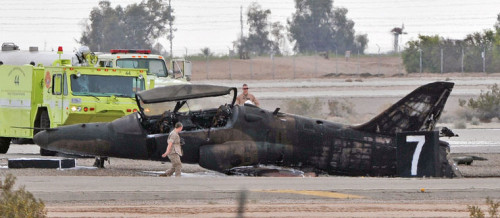The National Transportation Safety Board has published its investigation into the crash of a BAE Systems Hawk Mk 67 (former RoKAF T59) at Marine Corps Air Station Yuma on Mar. 11, 2015. The aircraft hit a stationary vehicle and killed a Marine inside it.

Photo by Randy Hoeft/Yuma Sun
Investigators found that the pilot of the warbird rotated 8 kts before rotate speed (Vr) and the jet was airborne 10 kts early. The mishap pilot said he felt the nose of the aircraft become light when approaching Vr. He probably had rotated early after experiencing the light nose feeling. The plane then roll and pitch violently, partly due to the addition of bomb racks, and the pilot struggled to bring the plane under control. The report said the Hawk was “bouncing from left to right with the outboard bomb dispensers and landing gear alternately striking the ground.” It then hit the pickup truck which was parked 150ft from the edge of the runway, the occupant was there to monitor construction works next to the runway.
It was found that the owner of the aircraft, Air USA, had modified the pitch trim settings to 3 degrees nose up. This is to help relieve stick pressure on rotation when taking off with external stores. However, it runs counter to the aircraft manual which states that the pitch trim should be set at 0 degrees for all take-off configurations. Air USA said the company policy “was intended to give the airplane control stick pressures on rotation comparable to other U.S. fighter aircraft, such as the FA-18 and F-16.” The setting has been in use on many prior missions without incident.
The board also took issue with the bomb racks that were fitted on the aircraft at the time of the incident. The type of dispensers were not approved by BAE Systems and Air USA had commissioned an Federal Aviation Administration (FAA)-designated engineering representative to do an assessment to see if they meet structural requirements. Although the dispensers was structurally satisfactory, it did not take into account the aerodynamic effects of using the alternate dispensers. NTSB believes the bomb racks may have eroded the airplane’s stall margin.
As for the construction work -for the installation of an arresting gear system – that was going on during the accident, the NTSB said the death of the Marine could have been avoided if FAA directives to suspend such activities when the runway is active was followed. Marine Corps Air Station Yuma is operated by the Pentagon but it is actually a shared civilian-military facility.
The U.S. Air Force also had to take some blame for the accident. It was found that the service had failed to provide adequate oversight into Air USA’s operations. The mission that day was contracted by the U.S. Air Force even though the jet took off from a U.S. Marine Corps air base. A Pentagon directive had allowed the flying branch to choose between the use of DoD or FAA airworthiness certification standards. The Air Force went along with the FAA oversight, but as the “jet’s missions were flown under the umbrella of “public aircraft,” the FAA was not providing, nor was it required to provide, any oversight beyond issuance of the airplane’s initial airworthiness certificate.” The Hawk was effectively being flown without oversight at the time of the accident.